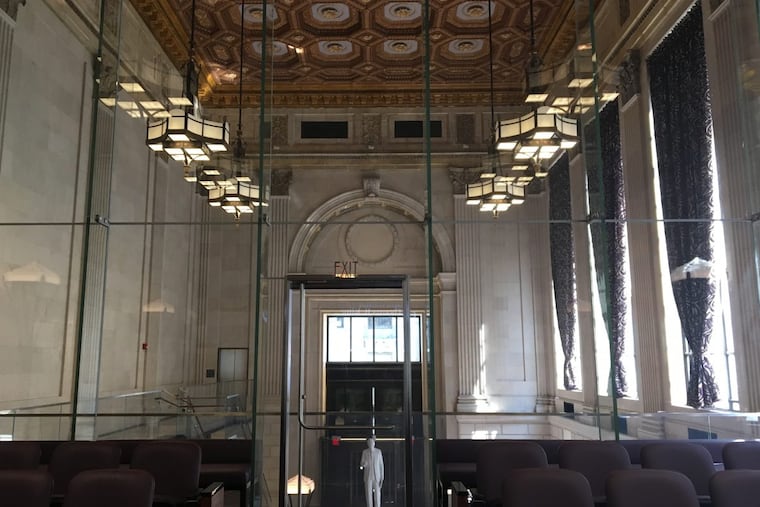How a Philadelphia lawyer turned a historic bank into a shrine to democracy (and his legal career)
The new Kline Institute of Trial Advocacy is another sign that the east side of Center City is on the rise.

If a corner building on a narrow urban site wants to assert itself, it had better stand up straight and speak in a forceful voice. Architect Horace Trumbauer's columned neoclassical temple at 12th and Chestnut did just that in the early 20th century for Beneficial Bank, which catered to Philadelphia's immigrant workers. And now it's teaching the same lesson to Drexel University's aspiring trial lawyers.
After sitting empty for a dozen years, the handsome, white granite building has been brought back to life by Drexel's Thomas R. Kline School of Law, which will use the building to teach courtroom skills. To give students the experience of practicing before a judge and jury, the architects at Tackett & Co. fitted out the former bank with five authentic courtrooms where professors can stage mock trials. Because the spaces can do double duty as regular classrooms, the building, known as the Kline Institute of Trial Advocacy, also serves as a lavish Center City campus for the law school.
Trumbauer's Beneficial Bank opened on Armistice Day in 1918, at the end of World War I, and has always stood out among Chestnut Street's more retail-focused buildings. Part of the reason is the building's scale: The thick Ionic columns rise nearly 40 feet as they march down 12th Street. What's interesting is the way Trumbauer extracted drama from the much narrower Chestnut Street side, in a tight urban streetscape. Although there is enough room for only two columns to flank a set of bronze entry doors, the procession up the short flight of steps into the soaring banking hall makes you feel like royalty.
The 40-foot-high banking floor, which once housed a large, circular tellers' desk, had become quite dingy over the years, but the renovation has restored its dazzling brightness. The architects extended an existing mezzanine to make room for an 80-seat courtroom. Because the glass wall enclosing the space is nearly invisible, the courtroom appears to hover over the former banking floor. The use of glass also ensures that visitors are still able to enjoy a full view of the banking hall, with its decorative blue-and-gold ceiling medallions. The architects also discreetly tucked a new staircase along the west wall of the hall.
Overseen by Powers & Co., a preservation consultant, every aspect of the renovation is meticulously executed. To preserve the architectural details, Tackett camouflaged the sprinkler and security systems, reused the original pendant lights, and created custom acoustical panels. None of this came cheap. The $23 million project was funded out of a $50 million donation that Kline made to the law school in 2014.
Kline, a crusading litigator who has won a series of high-profile personal injury cases, including one involving a boy who lost his foot on a faulty SEPTA escalator, actually acquired the building two years before he made the gift to Drexel's law school. "I was celebrating my 65th birthday and I decided to buy it as a present to myself," Kline explained during a tour.
At the time, he had no plans for the 20,000-square-foot building. But he had become fond of the structure when he worked nearby, in the office of James E. Beasley Sr., another fearsome and successful personal-injury lawyer who had also endowed a law school (Temple University, in his case).
Beasley was an early preservationist who rescued an important historic building, the Episcopal Church House at 12th and Walnut. He turned it into his office in 1986, long before such conversions had become common. In emulating his mentor, Kline has created a worthy bookend to that landmark.
The Beneficial renovation is both a shrine to one of democracy's bedrock values, trial by jury — and to Kline's career. A life-size sculpture of the lawyer, executed in white carrara marble by Christopher Collins, stands sentry near the entrance, and a small museum devoted to his career is being assembled on the bank's office floor. Exhibit A is an escalator, similar to the one in the SEPTA case.
Solid, neoclassical banks like Trumbauer's are often seen as architectural expressions of America's democratic values. In its new life as a law school, the renovated bank has become more than a symbol of those beliefs. It now plays a role in defending them.